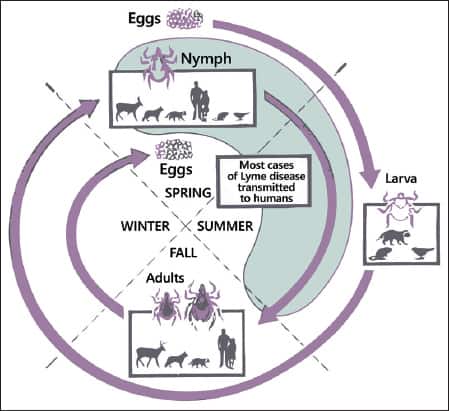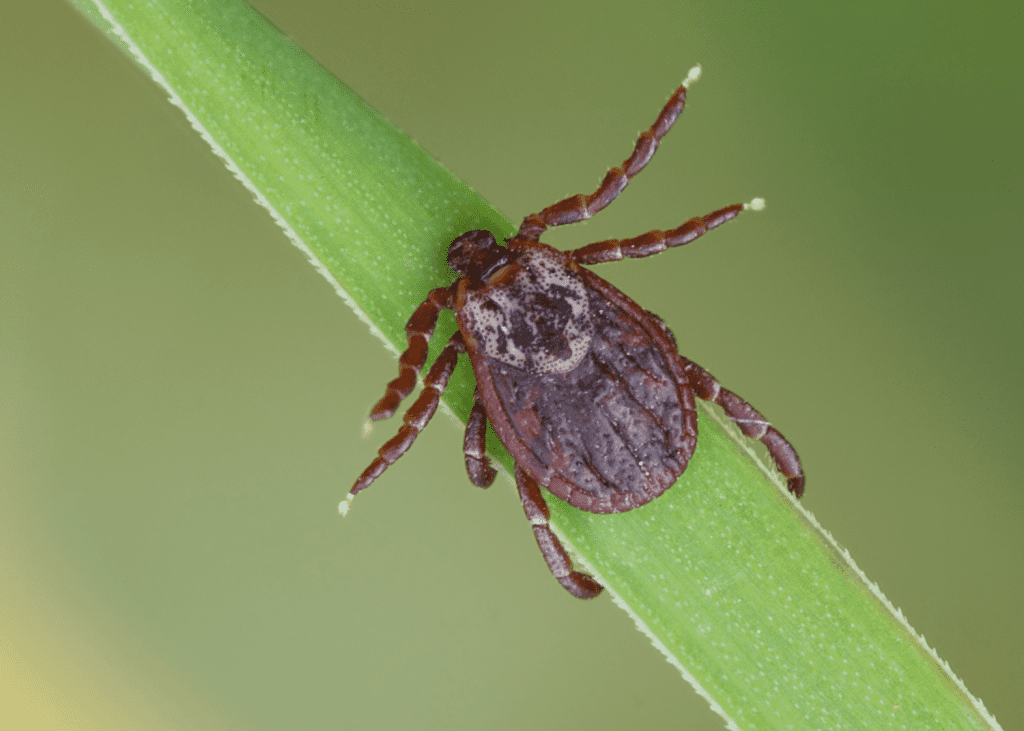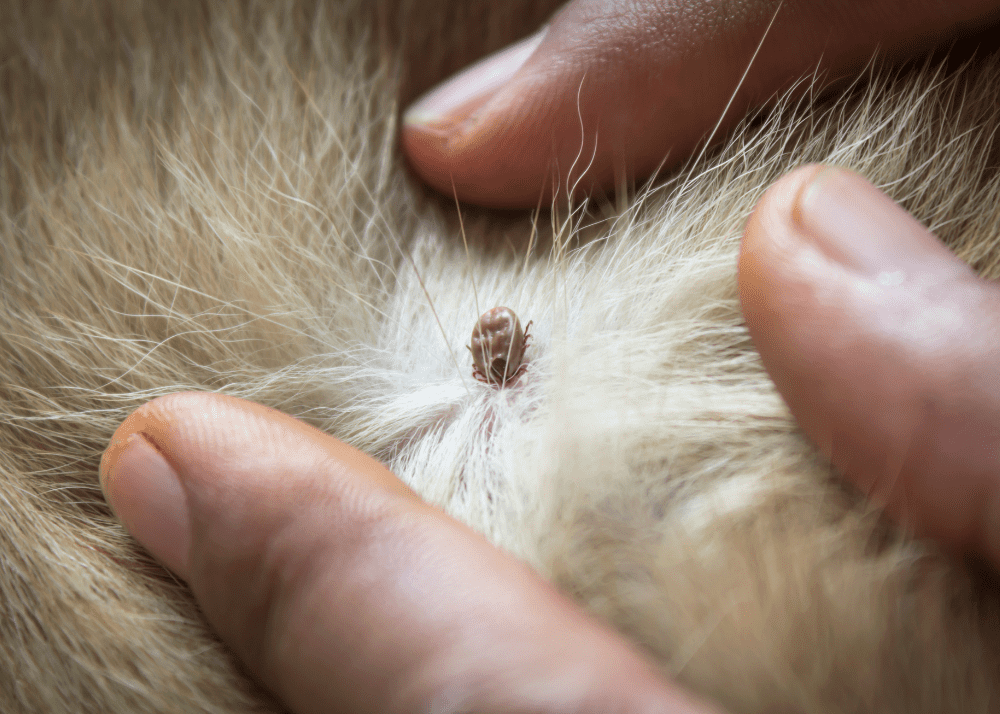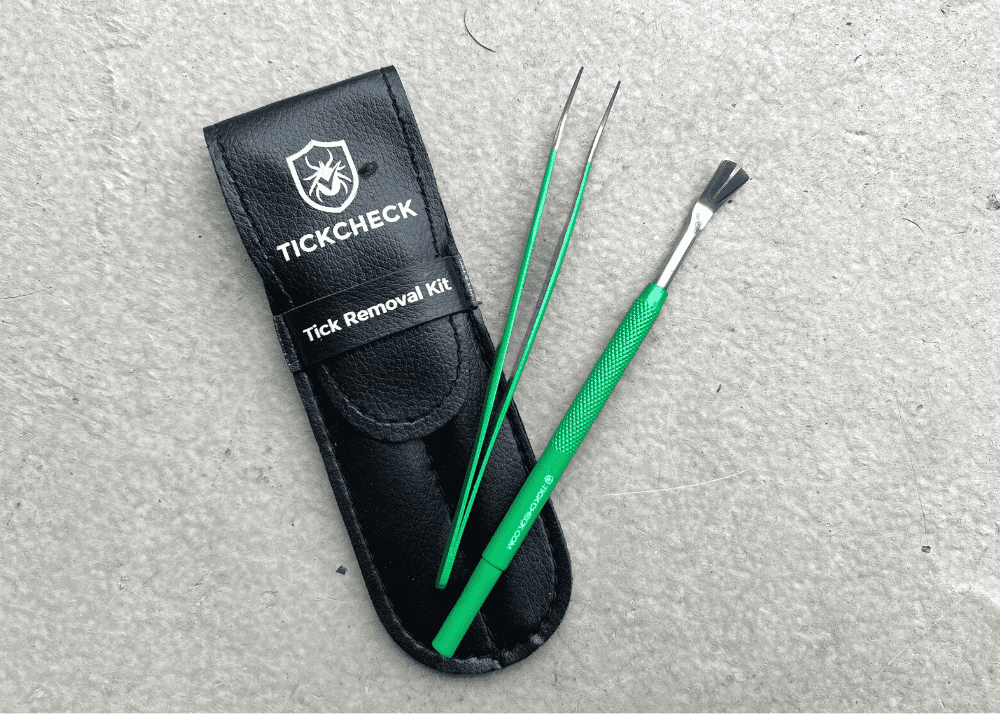What to Do About Cats with Ticks
Updated June 3, 2025
As you adventure outdoors with your cat, one of the biggest concerns you’ll need to take into consideration is ticks. Not only are they icky to look at, but they also pose a danger to both cats and us humans. Cats with ticks can develop various diseases, so it’s important to do what you can to prevent them.
Interested in an ad-free experience?
Come join the Trailblazers community and get access to ALL KittyCatGO articles with ZERO ads!

*Disclosure: This post contains affiliate links. If you make a purchase using one of these links, I will receive a small commission at no extra cost to you. This helps me to continue creating helpful content. Don’t worry – I would never recommend something I don’t like or use myself!
Much of the information shared in this article was gathered from an interview with Jonathan Weber, CEO of TickCheck. The full video interview is included at the bottom of this article.
Understanding Ticks
While you certainly can work to prevent ticks without knowing much about them, I’m a firm believer that the more you know, the better. By understanding the tick life cycle, the types of ticks that exist, the specific dangers they pose, and how your cat can pick up ticks, the better equipped you’ll be to prevent them and deal with them should your cat get one.
The Tick Life Cycle
On a yearly basis, there are generally two generations of ticks that are active. They have a multi-staged life cycle that lasts roughly 2 years (depending on the species), including the following stages:
- Larva – These are so tiny you can’t see them. They do not feed at this stage.
- Nymphs – This is the most dangerous stage because they’re so tiny that they’re nearly impossible to see, yet they DO feed. Nymphs begin showing up in March/April, peak around May/June, and then have reached adulthood by October/November.
- Adults – The final life stage of a tick. Adult ticks peak in June, and then lay their eggs in early spring to begin the life cycle over again.

During the winter months, ticks generally go into a low-energy state. This means once the temperatures are cold enough (generally less than 45°F, depending on the tick species), they will become dormant for days, weeks, or even months at a time. If the temperatures warm up enough though, even for a day, a tick may become active again.
Though many believe that ticks die off in the winter, experts say the weather must reach less than 10°F for multiple days at a time to actually kill ticks. With our winters getting warmer and warmer, this is happening less and less.
TickCheck CEO Jonathan Weber says that the best kind of winter to have to keep the tick population down is a cold, dry winter. If there is a lot of snow, the snow creates a protective layer for the ticks, helping them to live through the cold weather.
Is There a “Tick Season?”
According to the life cycle described above, the most active times for ticks are in late May/early June as well as in late October/early November. Armed with this knowledge, you and your cat can avoid exploring outdoors during those months in areas that are known to have a high tick population.

Is your cat meant for a life of adventure?
Let’s assess your cat’s personality to find out!
The Types of Ticks in the United States
Though there are close to 100 different tick species found in the United States, there are 4 main species that are known to bite humans and pets, including cats. The different species are found in different parts of the country, so depending on where you live, you and your cat will be more or less at risk for each type.
- Deer Tick – Deer ticks can be found anywhere, though they are most common along the eastern coast of the US, as far west as Texas, and also in the Great Lakes region. Deer ticks are known to be Lyme disease carriers. According to TickCheck’s statistics, 21% of the deer ticks that get sent in for testing test positive for carrying some sort of bacteria or disease.
- Western Blacklegged Tick – As the name suggests, they are found along the west coast, most commonly in California, Oregon, and Washington. Like deer ticks, they are known carriers of Lyme disease, as well as other bacteria and pathogens.
- Lonestar Tick – This tick species is most commonly found from the east coast to the Midwest. They used to be found mostly in the southern US, but they’ve been progressively moving northward. Lonestar ticks are unlikely to transmit Lyme disease, but they can transmit other diseases. According to TickCheck’s statistics, 16% of the Lonestar ticks that get sent in for testing test positive for carrying something.
- Dog Tick – There are two species of dog ticks: the Brown Dog Tick and the American Dog Tick. The brown dog tick is found across the entire US, while the American dog tick is mostly on the eastern half of the US and in California. Though unlikely to transmit Lyme disease, they are known carriers of Rocky Mountain Spotted Fever and other diseases. According to TickCheck’s statistics, 3% of dog ticks that get sent in for testing test positive for carrying something.
How Your Cat Can Pick Up Ticks
Though you might think that ticks can only be picked up in densely wooded areas, that’s not true. Though they certainly do inhabit those places, they also make their home in your yard. Ticks tend to follow the host (most commonly deer and mice), so if you have a lot of deer and mice that wander through your yard, you will be more likely to have a higher tick population.
So whether you and your cat enjoy backyard hangs or going for hikes in the woods, you’ll need to be proactive about dealing with the possibility of ticks, since they can be picked up just about anywhere.
When ticks are searching for a host, they engage in what is called “questing.” Questing is when they climb up a blade of grass or twig, sit on the end, and wave their legs until something brushes past them. They can detect carbon dioxide, so when they see something coming by that gives of CO2 (such as your cat or yourself), they will go after that.
Despite the myth that ticks will jump down on you from above, this has been debunked on multiple occasions. Jonathan Weber explains that ticks remain low to the ground – they don’t climb high, going no more than a few feet off the ground. They quest from tall grass, low bushes, and low vegetation. When not questing, they can be found on the ground and in leaf litter.

The Dangers of Cats with Ticks
Ticks can carry and transmit up to 30 different pathogens. Some of these are more serious than others, and some aren’t a concern for cats at all. That being said, there is still much that we don’t know in regard to the dangers of cats with ticks.
The good news is that cats are very meticulous groomers, which works in their favor when it comes to ticks. If a cat gets a tick, they will usually groom it off quickly before the tick has a chance to transmit any disease. (Don’t worry – there is no risk to your cat if they ingest a tick.)
A tick has to be attached to its host for a certain amount of time to actually transmit disease. The amount of time varies for each disease, but 24-48 hours is generally the window of opportunity. So the faster your cat (or you) removes the tick, the less risk there is of infection.
When asked if there are certain diseases that are more of a concern for cats than others, Jonathan Weber said, “The hard answer to this is there’s not a lot of research about this.” He went on to explain that new diseases continue to be discovered that are transmitted by ticks, such as the Powassan virus. Because it is newer, there isn’t much research on its transmission via ticks or its effects on humans, let alone on cats.
There are, however, are a few diseases transmitted via tick bite that are known to affect cats.
Cytauxzoonosis
Cytauxzoonosis (aka Bobcat Fever) is a tick-borne parasitic disease that infects the cat’s blood cells. The most common carrier of the parasite responsible for this disease is the Lonestar tick. Symptoms include:
- lack of energy
- lack of appetite
- pale gums
- difficulty breathing
- fever
- increased heart rate
This disease progresses quickly and is life-threatening, so if your cat becomes ill after a tick bite, see your veterinarian right away.
Feline Hemotrophic Mycoplasmosis (previously known as hemobartonellosis)
FHM is a disease caused by a parasite that infects a cat’s red blood cells. This parasite can be transmitted through tick bites and causes severe anemia. FHM is life-threatening, so it’s important to get your cat to the vet right away if you notice any of the following symptoms:
- Sudden onset of fever
- Pale gums
- Lethargy
- Rapid or open mouth breathing
- Weakness
- Loss of appetite
- Jaundice
Tularemia
Though rare, tularemia is a potentially fatal bacterial infection that can be caused by an infected tick bite. Symptoms include:
- High fever
- Depression/lethargy
- Abdominal pain
- Jaundice
- Vomiting
- Dehydration
- Weakness
- Oral ulcers and abscess
As with the previously mentioned diseases, tularemia progresses quickly and can be life-threatening, so get your cat to your veterinarian right away if you suspect they are sick.
Can a Cat Get Lyme Disease?
The short answer is yes; however, it is not very common. On the rare occasion a cat does contract Lyme disease, it is usually much less severe than in humans. Their immune system is quite adept at fighting it off, and in most cases, they won’t ever even show signs they had it at all. In conclusion, Lyme disease is not much of a concern for cats.
Can a Cat Get Rocky Mountain Spotted Fever?
As with Lyme disease, cats can contract RMSP, but it isn’t much of a concern. Though a tick only needs to be attached for 5 hours to transmit RMSP, a cat will likely not even show symptoms.

Cat Tick Prevention
The best and most obvious way to avoid any complications caused by ticks is to prevent them. Thankfully there are several things you can do to prevent your cat from getting ticks.
Tick Preventative Medicine
There are several tick preventatives available in chewable, pill, and topical forms. They are usually combined with a flea preventative. Talk to your veterinarian to figure out which type is the best choice for your cat.
If you aren’t a fan of treating your cat with chemicals, there are some natural options out there. They don’t tend to work quite as well, so it’s usually advised to combine a natural preventative with another kind of preventative, such as an ultrasonic tick repellent tool (more on that below). You also have to be careful with natural preventatives, as many of them contain essential oils that are toxic to cats. Wondercide is a popular natural flea and tick preventative that is safe for cats.
Ultrasonic Tick Repellent Tool
Ultrasonic tick repellent tools are becoming popular as a chemical-free way to prevent fleas and ticks. They work by emitting a series of ultrasonic pulses that are imperceptible to humans or animals but that interfere with a tick’s ability to orient themselves. The Tickless Cat is a popular one in the cat-adventure community. According to Tickless, the device has a 94% efficiency against ticks.
Do Tick Checks on Your Cat
Before going back inside after an adventure, always do a tick check on your cat. Use your hands to feel around on your cat’s body, especially places they can’t easily groom like the nape of their neck, heads, ears, and back. Be sure to also check your cat’s arm pits and between their toes, as ticks like finding out-of-the way places to attach themselves. Use your eyes to do a visual check as well.
You can also run a flea comb through your cat’s fur to remove any ticks that might be loose. Be careful running the comb right up against your cat’s skin though because if a tick is already attached, running the comb over it could break the head off but leave the mouth parts still attached, which can still cause an infection or transmit harmful pathogens.
I recommend doing the tick checks BEFORE you and your cat go back inside so you don’t run the risk of your cat dropping a tick in your home, only to pick it back up again later.
Reduce Ticks in Your Yard
While you don’t have any control over the tick population in the great outdoors, you do have some control over your own yard. Keeping your grass cut low goes a long way to reduce tick populations.
You can also use products such as Wondercide to spray your yard or place tick tubes around your yard. Tick tubes are small cardboard tubes filled with cotton that has been treated with permethrin insecticide. Mice collect the cotton to build their nests, taking the treatment back with them, which then kills off the ticks on the mice.
Another natural way to control the tick population in your yard is to add some chickens to your family, as they will feed on ticks. Possums also eat ticks, so you can encourage possums in your yard by planting the appropriate shrubs and ground cover for them and providing a water source.
Choose Your Adventure Spots Wisely
Knowing that ticks thrive in environments with tall grasses, you can help prevent ticks on your cat by avoiding walking through tall grasses. If you’ll be adventuring outdoors during the peak tick season, you can select places to walk that are less overgrown – such as places with paved walking trails or hiking trails with wide paths. You may even opt to avoid wooded hikes completely during the peak tick seasons.

Is your cat meant for a life of adventure?
Let’s assess your cat’s personality to find out!
Removing Ticks on Your Cat
Even if you do all you can to prevent ticks, your cat may still get them from time to time if you spend a lot of time outdoors together. If you do happen to find an attached or embedded tick on your cat, it’s important to remove it properly.
When removing a tick, you want to make sure you don’t squeeze it at all, or you’ll inject your cat with the bacteria that’s inside the tick. Steer clear of using things like soap, alcohol, Vaseline, or any other kind of substance that is sometimes encouraged as an effective tick removal method. Though using these products will remove the tick, the tick will likely regurgitate into the wound before removing itself, which injects bacteria into your cat.
The ONLY way to properly remove a tick is with a tick removal tool. Effective tick removal tools include:
- Ultra-fine tipped tweezers – These work well for small ticks. Use the tweezers to grab the tick from behind, grabbing its mouth parts. Be sure not to squeeze the tick’s abdomen. Pull straight out.
- Tick removal fork – These are best for larger ticks or engorged ticks. Slide it in from behind, putting the fork over the tick’s mouth parts and lift out.
- The TickCheck Tick Remover Kit includes both ultra-fine tipped tweezers and a tick removal fork.
Be sure to remove all parts of the tick to avoid infection, and include a tick removal tool in your cat’s first aid kit so it’s always handy.

TickCheck Services
If you find a tick embedded on your cat and are concerned, you can send it off to be tested for up to 30 different pathogens. Using TickCheck’s Tick Testing services, you can choose between 3 different levels of testing panels. Time is of the essence if you suspect your cat contracted a tick-borne disease, so you can rest easy knowing you’ll receive the test results within 48 hours of TickCheck receiving the tick.
If you don’t feel like a test is necessary, you can utilize the TickCheck Tick Identification service by sending a clear photo of the tick, and they will identify the species for you free of charge. Even if you happen to know the species already, sending in the photo is helpful for research and tracking purposes.
KittyCatGO LIVE: Season 2, Episode 10 – Tick Safety & Prevention with Jonathan Weber
There is obviously a LOT to understand about ticks and how they concern you and your cat. While many of the more common tick-borne disease are not as big of a concern for cats as they are for humans (or even dogs), there are still some dangers posed to cats with ticks. As we adventure outdoors with our cats, it should always be our goal to provide the safest experience possible, which means doing what we can to prevent against ticks. The more we know, the better we do!

About the Author
Emily Hall, ABCCT is a certified cat trainer and cat adventure enthusiast. As a “mom” to five cats and one dog, she has been writing in the pet industry for over 10 years, with a focus on traveling and adventuring with cats.
Emily has a passion for getting out there and doing more with her cats – for pushing the bounds of cat expectations! She and her husband enjoy hiking, road-tripping, camping, and canoeing with their three cat adventurers. Read more about Emily here.







Emily, this was a fascinating read; thank you! Admittedly, I’m one of those cat moms/lovers who knew the dangers of ticks but didn’t fully understand the mechanics of it or what the diseases were called. It’s so important that we stay educated on the different things that can affect our little ones, especially if there are outdoor excursions. 🙂
The TickCheck services are incredibly valuable as well; you’re awesome for sharing that resource. I’d never heard of it! We have some summers here when tick numbers get very high. Our local Vet will often send out e-mail reminders to be sure and have active protection for our pets. For our four rescues, we have had an excellent experience with Seresto for several years now. It’s the only flea and tick preventive one of our cats can use because she is allergic to the rest. As you mentioned, we’re not fans of chemicals but sometimes…there isn’t much choice.
Thank you again. Wonderful tips here that are sure to help pet parents everywhere. Love to you & your furry family! ❤️
I wasn’t aware of all the mechanics either until I interviewed Jonathan with TickCheck. It was an eye-opening interview for sure, so I knew I wanted to do this write up to spread the word to hopefully help others.
Ticks get so bad down here in Georgia in the summer, it makes it almost impossible to enjoy a hike. I’m sorry to hear you deal with that too. They’re such a disgusting nuisance!
Anyway, thanks for reading and leaving a comment! Love to you and your furry family as well <3